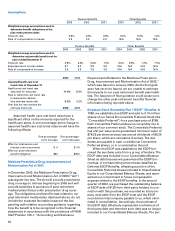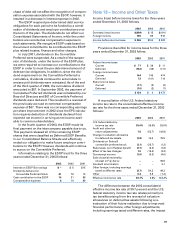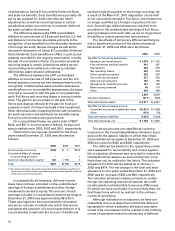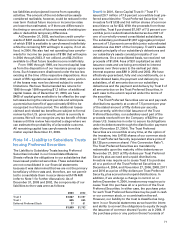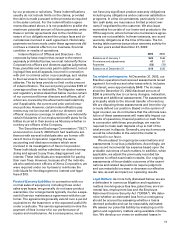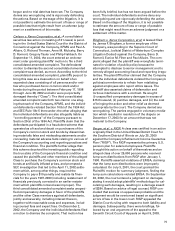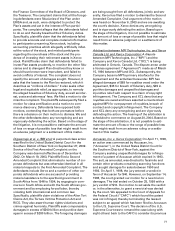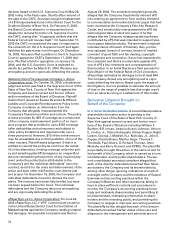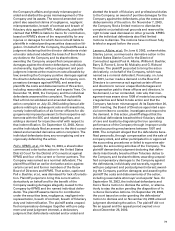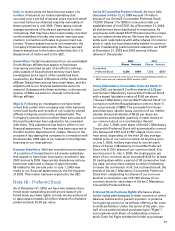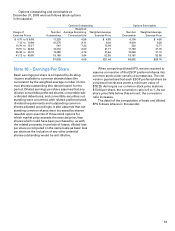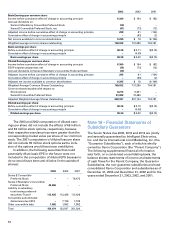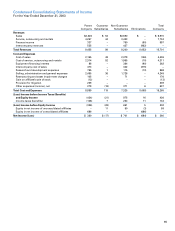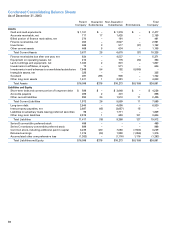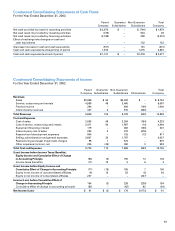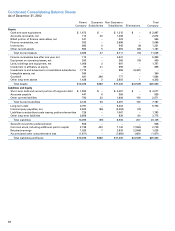Xerox 2003 Annual Report Download - page 80
Download and view the complete annual report
Please find page 80 of the 2003 Xerox annual report below. You can navigate through the pages in the report by either clicking on the pages listed below, or by using the keyword search tool below to find specific information within the annual report.
78
decision based on the U.S. Supreme Court’s May 28,
2002 ruling in the Festo case. Shortly after remand of
the case to the CAFC, Accuscan sought reinstatement
of a $10 supersedeas bond in the District Court for the
Southern District of New York. On February 5, 2003,
the District Court refused to re-impose the bond,
despite the remand from the U.S. Supreme Court to
the CAFC, stating that “it [appears] unlikely that the
Federal Circuit will reverse itself.” On September 17,
2003 the CAFC reconsidered the case (in response to
the remand from the U.S. Supreme Court) and again
held that the patent was not infringed. On December
15, 2003, Accuscan filed a petition to the U.S. Supreme
Court to appeal the CAFC’s September 17, 2003 deci-
sion. We filed a brief in opposition on January 14,
2004, and the U.S. Supreme Court is expected to
decide the petition by March 31, 2004. We deny any
wrongdoing and are vigorously defending the action.
National Union Fire Insurance Company v. Xerox
Corporation, et al.: On October 24, 2003, a declaratory
judgment action was filed in the Supreme Court of the
State of New York, County of New York against the
Company and several current and former officers
and/or members of the Board of Directors. Plaintiff
claims that it issued an Excess Directors & Officers
Liability and Corporate Reimbursement Policy to the
Company in reliance on information from the
Company that allegedly misrepresented the
Company’s financial condition and outlook. The policy
at issue provides for $25 of coverage as a component
of the company reimbursement portion of an insur-
ance program that provides for up to $135 coverage
(after deductibles and coinsurance and subject to
other policy limitations and requirements) over a
three-year period. However, $10 of the entire amount
may be unavailable due to the liquidation of one of the
other insurers. Plaintiff seeks judgment (i) that it is
entitled to rescind the policy as void from the outset;
(ii) in the alternative, limiting coverage under the poli-
cy and awarding plaintiff damages in an unspecified
amount representing that portion of any required pay-
ment under the policy that is attributable to the
Company’s and the individual defendants’ own mis-
conduct; and (iii) for the costs and disbursement of the
action and such other relief as the court deems just
and proper. On December 19, 2003, the Company and
individual defendants moved to dismiss the com-
plaint. The motions have been fully briefed, but have
not been argued before the Court. The individual
defendants and the Company deny any wrongdoing
and are vigorously defending the action.
ePaperSign, LLC v. Xerox Corporation: On June 24,
2003 ePaperSign, LLC (“ePS”) commenced an action
in the United States District Court for the District of
Massachusetts against the Company, seeking unspeci-
fied damages. An amended complaint was filed on
August 29, 2003. The amended complaint generally
alleges that the Company fraudulently induced ePS
into entering an agreement to form entities intended
to commercialize and market electronic paper that had
been invented at the Company’s Palo Alto Research
Center, and intentionally misrepresented to ePS the
technological state of electronic paper. It further
alleges that the Company misappropriated software
contributed by ePS that was intended to support elec-
tronic paper based products. The amended complaint
includes claims of breach of fiduciary duty, promis-
sory estoppel, breach of contract, breach of implied
covenant of good faith and fair dealing, copyright
infringement and conversion. Xerox has responded to
the complaint and filed a counterclaim against ePS,
one of ePS’s four members and a representative of
that member. In an Initial Disclosure filed pursuant to
Rule 26(a)(1) of the Federal Rules of Civil procedure,
ePaperSign estimates its damages to be at least $44.
The Company denies any wrongdoing and is vigor-
ously defending the action. Based upon the stage of
the litigation, it is not possible to estimate the amount
of loss or the range of possible loss that might result
from an adverse ruling or a settlement of this matter.
Derivative Litigation Brought on
Behalf of the Company:
In re Xerox Derivative Actions: A consolidated putative
shareholder derivative action is pending in the
Supreme Court of the State of New York, County of
New York against several current and former mem-
bers of the Board of Directors including William F.
Buehler, B.R. Inman, Antonia Ax:son Johnson, Vernon
E. Jordan, Jr., Yotaro Kobayashi, Hilmar Kopper, Ralph
Larsen, George J. Mitchell, N.J. Nicholas, Jr., John E.
Pepper, Patricia Russo, Martha Seger, Thomas C.
Theobald, Paul Allaire, G. Richard Thoman, Anne
Mulcahy and Barry Romeril, and KPMG. The plaintiffs
purportedly brought this action in the name of and for
the benefit of the Company, which is named as a nom-
inal defendant, and its public shareholders. The sec-
ond consolidated amended complaint alleged that
each of the director defendants breached their fiduci-
ary duties to the Company and its shareholders by,
among other things, ignoring indications of a lack of
oversight at the Company and the existence of flawed
business and accounting practices within the
Company’s Mexican and other operations; failing to
have in place sufficient controls and procedures to
monitor the Company’s accounting practices; know-
ingly and recklessly disseminating and permitting to
be disseminated, misleading information to share-
holders and the investing public; and permitting the
Company to engage in improper accounting practices.
The plaintiffs further alleged that each of the director
defendants breached his/her duties of due care and
diligence in the management and administration of


